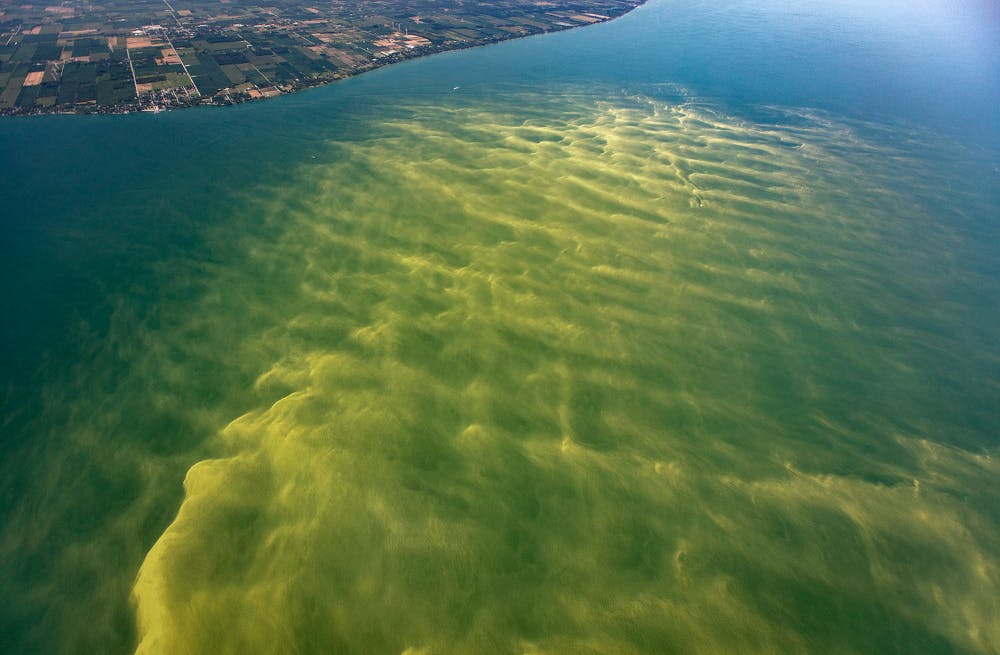By: Erin Fisher
Lake Erie has been a collection site for human, industrial and agricultural wastes for decades. In fact, in Alex Prud'homme’s book The Ripple Effect: The Fate of Freshwater in the Twenty-First Century (2012), he recalls that by the late 1960’s, Lake Erie had become so contaminated that it was pronounced biologically dead. Garnering national attention for its proneness to burst into flames, Erie has been credited with inspiring Earth Day in 1970 to the establishment of the Clean Water Act (CWA) in 1972, according to Dan Egan’s book The Death and Life of the Great Lakes (2018). And while these movements were a step in the right direction, the CWA and contaminant consciousness of the 1970’s have long slipped from the minds of Congress and the public, leaving Lake Erie to suffer from a vast multitude of unrestrained and widely unnoticed threats.Years ago, the public received an unnerving warning about a particularly pressing threat from an author concerned with the declining health of the once great Lake. “Fish walk on their fins and get woefully weary, in search of some water that isn’t so smeary”, Dr. Seuss wrote in his 1971 classic the Lorax. “I hear, things are just as bad up in Lake Erie”. The smeariness Seuss referred to was a blanket of neon green several inches thick that began appearing each summer on the Lake. Known scientifically as toxic algal blooms, they were initially addressed the year after the Lorax was published, Alex Prud'homme observes (2012) when the United States agreed to team up with Canada to reduce their phosphorus discharges to the lake by more than half. Today, however, Seuss’s concern has fallen to the same fate as the CWA, as these toxic blooms have once again become increasingly and alarmingly frequent. Though most residents of the Lake Erie watershed see them as merely an unsightly inconvenience, algal blooms pose a significant threat to the ecosystem. An Exceptional EcosystemLake Erie is the most biologically productive of the Great Lakes, home to 1,500 species of plant and animal life and supporting over 50 percent of the total fish population in the Great Lakes, Dan Egan (2018) reports. Erie’s nutrient-rich environment also appeals to human habitation, with over 12 million people or ⅓ of the entire population of the Great Lakes basin living within the watershed. Consequently, this habitation has resulted in heavy urbanization, bringing combined sewer overflows and impervious concrete surfaces to an already nutrient-heavy agricultural region. This combination places the watershed in a deadly crossfire of nutrient pollution.Under Agribusiness’s Green ThumbKnown to most Ohioans, the Lake Erie Basin— all of the surrounding lands that drain into the lake— is a largely agricultural region. Even though industrial waste, sewage and lawn fertilizer also contribute to the problem, “agriculture is the biggest source of the phosphorus and nitrogen that nurture harmful blooms”. In the past, the causes and effects of algal blooms were largely unknown. Yet, the larger body of scientific knowledge we have today has produced few changes or solutions. The fault likely lies with the influence of special interests, which encourage government inaction and prevent regulations on behalf of the agricultural industry. Ohio is one of the leading agricultural states in the U.S, with food production and agriculture as its #1 industry. As a result, lawmakers are having significant difficulty combatting the farming practices that lie at the root of the problem. The repercussions of which allow algal blooms to threaten not only the health of Lake Erie, but the ecosystem, economy and residents that depend on it.Though as algal blooms become increasingly frequent, they become harder to ignore. After the Toledo water crisis in 2014, which kept over 500,000 residents from drinking water for days, regional farmers began to “understand the sense of urgency, and want to do more to curb runoff”. Joining the Farm Bureau, the Ohio Nature Conservancy and Ohio State University scientists, farms across the state are now volunteering to participate in nutrient stewardship and research programs to study the role farmers play in triggering the blooms. But in order for lasting remediation and prevention to occur, local, state and federal governments will need to increase research, education and funding efforts. In other words, a swift and sweeping change in societal values will be necessary to garner to the political willpower to challenge the status quo. Constituents and lawmakers alike must recognize that the value a healthy Lake Erie provides to multiple regions and countries far outweigh the initial costs to the agriculture industry.A Framework for the FutureIdeally, because Lake Erie’s water quality is affected by the actions of all parties in the watershed, these issues should be addressed by the collaboration of all parties. The inclusion of multiple jurisdictions would provide the funding and accountability necessary to create a framework that is more than just an agreement on a desired outcome. Yearly targets for the phase-out of dissolved phosphorus fertilizers, reconstruction of farming practices and penalties for noncompliance should be included. If the stewards of such a great Great Lake continue with permissive and reactionary policy, there is a lot to lose. The health of Ohio’s ecosystem, economy and citizens depend on a healthy Lake Erie. The question is, without cohesion at the state, federal and local levels, how long will the Lake Erie ecosystem be able to wait?Photo Credit: Aerial Associates Photography, Inc. by Zachary Haslick

